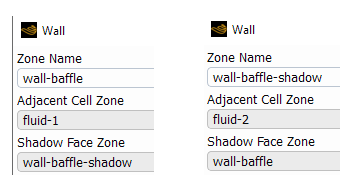Boundaries in Ansys Fluent can be broken into two groups: external boundaries and internal boundaries. External boundaries appear on the outer boundary of meshed regions (inlets, outlets, interfaces, etc.), while internal boundaries exist within a conformal mesh (interiors, porous-jumps, fans, etc.). Notably, internal boundaries can exist inside a single cell zone, or can even separate different cell zones as long as the mesh is conformal across the boundary. There is one boundary type that can be used as either an external or internal boundary: walls.
While external walls are straight forward, internal walls are a bit more complex. Internal walls are sometimes called coupled walls or two-sided walls because they are formed by a pair of wall boundaries that are by default coupled together. You most often see coupled walls separating fluid and solid cell zones, but they can also be used as infinitely thin baffles with fluid on both sides. Each coupled wall pair shows up in the boundary list as a zone and its shadow: one for each side of the wall. When the coupled wall is between two different cell zones, it is easy to determine which side faces which cell zone as the adjacent cell zone is listed in the boundary condition window.

It is possible for a two-sided wall to exist between a single cell zone. When this occurs, the above reference to the “adjacent cell zone” is no longer useful to determine which side of the wall faces a particular direction. In these instances, it is possible to plot the face area in the direction most aligned with the boundary’s normal direction. The face area vector points from the adjacent cell into the wall (this is opposite of face normal direction). Note that you must initialize the solution to be able to generate the necessary contour plot.
In the below example, the “X Face Area” is plotted on the wall-baffle-shadow zone. The plot shows that the area is largely negative, which implies that this wall faces the +X direction. While this may initially seem backwards, keep in mind that the face area points from the adjacent cell towards the wall. This is backwards of the outward facing normal direction.

Hopefully this article sheds some light on wall/wall-shadow pairs. If you require further assistance with this topic, please contact us at support@drd.com.
